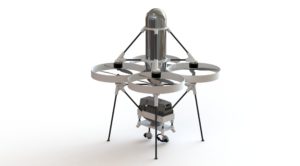 Last week’s InterDrone convention noticed a lot of recent and modern merchandise introduced. One of probably the most fascinating was the results of a partnership between CA-based FlightWave Aerospace Systems, Inc. and UK-based Intelligent Energy: the hydrogen-powered Jupiter-H2.
Last week’s InterDrone convention noticed a lot of recent and modern merchandise introduced. One of probably the most fascinating was the results of a partnership between CA-based FlightWave Aerospace Systems, Inc. and UK-based Intelligent Energy: the hydrogen-powered Jupiter-H2.
The Jupiter doesn’t appear to be lots of the different drones on show. It’s not a glossy marvel of aerodynamic design like FlightWave’s fixed-wing Edge drone. Nor does it appear to be any of the opposite multi-rotors on show on the present. Jupiter was designed with a very particular objective in thoughts – to offer an endurance drone for indoor (or outside in some circumstances) industrial use.
The hydrogen gasoline cell expertise that powers Jupiter comes via their partnership with Intelligent Energy. FlightWave CMO Edmund Cronin met the crew at Intelligent at an earlier InterDrone convention – and mentioned he knew they had been a excellent match for FlightWave. “Their solution is absolutely unique – we knew they would be great partners to create exactly the drone we wanted,” mentioned Cronin. “I held the fuel cell in my hand and couldn’t believe how lightweight it was. ”
The Jupiter isn’t the primary hydrogen powered business drone we’ve seen, but it surely’s vastly smaller than different choices, making it applicable for a broad number of functions; and it makes use of a widespread three liter tank for gasoline. The tank offers virtually 2 hours of flight time. “We used the tank because it’s so easy to source,” mentioned Cronin. “It’s cheap, easy to order, very stable, and incredibly safe.” It’s a extra accessible answer, available to enterprise clients.
The Jupiter-H2 combines its 2 hour flight endurance with lifting capabilities – as much as about three kilos of payload. The guarded blades, mild weight, slim profile of 70 cm and quiet operation make it excellent for indoor functions. The drone’s maneuverability means it might navigate a slim warehouse aisle subsequent to an automated forklift.
“We view the Jupiter-H2 as a game-changing vehicle,” mentioned Cronin. “It’s particularly well suited to use cases requiring both long flight time and stable manoeuvrability in narrow indoor or outdoor spaces — for example, in a very large but cramped warehouse.”
It’s a chic concept, and one we haven’t seen earlier than. “The Jupiter-H2’s composite airframe maximizes strength, minimizing structural weight,” says the corporate. The design permits for simultaneous use of a number of sensors and cameras – and subsystems can draw energy straight from the gasoline cell. Without the limitation of battery life, that is a important benefit: it reduces the general weight of the drone. The common mount system can accomodate virtually any sensor that the shopper desires. Refueling is fast and simple.
The Jupiter H-2 could not appear to be drones we’re used to seeing on the road – but it surely could possibly be a answer we get used to seeing on the job.
 Unmanned Aerial Vehicle The latest drone news
Unmanned Aerial Vehicle The latest drone news



